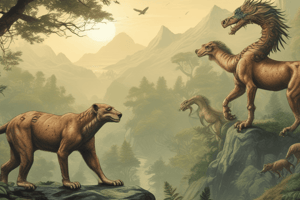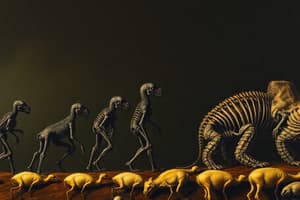Podcast
Questions and Answers
Which statement best describes the concept of evolution?
Which statement best describes the concept of evolution?
- Evolution focuses on variations within populations being inconsequential.
- Evolution means each species remains fixed and unchanging since its origin.
- Evolution involves populations changing over time through descent with modification. (correct)
- Evolution is about creating new species independently in each environment.
What is the term for the view that the biological world contains discrete types with little variation within them?
What is the term for the view that the biological world contains discrete types with little variation within them?
- Fixed species perspective
- Darwinian thinking
- Essentialism (correct)
- Population thinking
How did Darwin's study of finches in the Galápagos Islands contribute to supporting the idea of evolution?
How did Darwin's study of finches in the Galápagos Islands contribute to supporting the idea of evolution?
- By proving that all finches evolved from a single common ancestor.
- By showing that animals never change their characteristics.
- By illustrating how natural selection can lead to the formation of new species over time. (correct)
- By demonstrating how finches are all the same species despite different beak sizes.
Which of the following traits in sunflowers is an example of natural selection for survival and reproduction?
Which of the following traits in sunflowers is an example of natural selection for survival and reproduction?
What distinguishes population thinking from essentialism in terms of variation?
What distinguishes population thinking from essentialism in terms of variation?
What happened to the peppered moths when factories caused pollution and darkened the trees?
What happened to the peppered moths when factories caused pollution and darkened the trees?
Which scientist is associated with the concept of 'Catastrophism' after studying the fossil record?
Which scientist is associated with the concept of 'Catastrophism' after studying the fossil record?
What did Carolus Linnaeus believe about species?
What did Carolus Linnaeus believe about species?
What did Georges Cuvier study in relation to his concept of Catastrophism?
What did Georges Cuvier study in relation to his concept of Catastrophism?
Which scientist proposed the idea of 'Gradualism' linked to slow and continuous processes leading to significant changes?
Which scientist proposed the idea of 'Gradualism' linked to slow and continuous processes leading to significant changes?
Flashcards are hidden until you start studying
Study Notes
Evolution Concept
- Evolution is the concept that describes the gradual change of species over time through natural selection, genetic drift, mutation, and gene flow.
Essentialism vs. Population Thinking
- Essentialism is the view that the biological world contains discrete types with little variation within them.
- Population thinking, in contrast, emphasizes the importance of variation within populations to understand the process of evolution.
Darwin's Finches
- Darwin's study of finches in the Galápagos Islands contributed to supporting the idea of evolution by showing that different finch species had distinct beak shapes and sizes adapted to their specific environments.
Natural Selection
- The tall stem length of sunflowers is an example of natural selection for survival and reproduction, as it allows them to compete more effectively for sunlight and resources.
Peppered Moths
- When factories caused pollution and darkened the trees, the peppered moths evolved from a light-colored to a dark-colored morph, providing an example of adaptation to a changing environment.
Catastrophism
- Georges Cuvier, a French scientist, is associated with the concept of Catastrophism, which suggests that sudden, catastrophic events have shaped the Earth's history.
- Cuvier studied fossils to support his concept of Catastrophism.
Carolus Linnaeus
- Carolus Linnaeus believed that species are fixed and unchanging, and that each species has a distinct, essential characteristics.
Gradualism
- Charles Lyell, a British scientist, proposed the idea of Gradualism, which suggests that slow and continuous processes, such as geological changes, have led to significant changes over time.
Studying That Suits You
Use AI to generate personalized quizzes and flashcards to suit your learning preferences.




